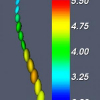Free Online Productivity Tools
i2Speak
i2Symbol
i2OCR
iTex2Img
iWeb2Print
iWeb2Shot
i2Type
iPdf2Split
iPdf2Merge
i2Bopomofo
i2Arabic
i2Style
i2Image
i2PDF
iLatex2Rtf
Sci2ools
ISBI
2006
IEEE
2006
IEEE
3D anatomical variability assessment of the scoliotic spine using statistics on Lie groups
We present a method to analyse the variability of the spine shape using rigid transforms. The spine was expressed as a set of rigid transforms that superpose local coordinates systems of neighbouring vertebrae. Those transforms were computed from anatomical landmarks reconstructed in 3D using two radiographs. Since rigid transforms do not belong to a vector space, conventional mean and covariance could not be applied. The Fr?chet means and a generalized covariance computed in the exponential chart of the Fr?chet mean were used instead. Those statistics were computed for each intervertebral transforms of a group of 307 untreated scoliotic patients. The variability of inter-vertebral transforms was found to be inhomogeneous (lumbar vertebrae were more variable than the thoracic ones) and anisotropic (with maximal rotational variability in the coronal plane and maximal translational variability in the axial direction).
ISBI 2006 | Maximal Rotational Variability | Maximal Translational Variability | Medical Imaging | Rigid Transforms |
| Added | 20 Nov 2009 |
| Updated | 20 Nov 2009 |
| Type | Conference |
| Year | 2006 |
| Where | ISBI |
| Authors | Jonathan Boisvert, Xavier Pennec, Nicholas Ayache, Hubert Labelle, Farida Cheriet |
Comments (0)

